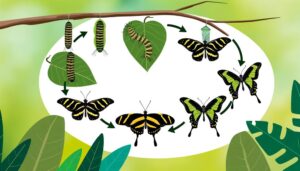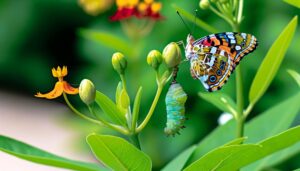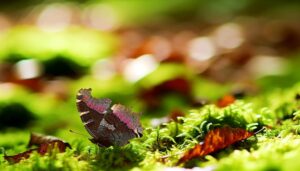How to Identify the Mourning Cloak: Black Butterfly with Yellow Edges
The Mourning Cloak butterfly (Nymphalis antiopa) exhibits dark maroon wings with distinctive pale yellow edges and iridescent blue spots. Possessing a wingspan of 62 to 75 mm, it features scalloped wing margins and a cryptic brown ventral side.
This species is widespread across North America, Europe, and Asia, inhabiting diverse environments such as woodlands and suburban gardens. Its lifecycle includes multiple stages from egg to adult, with larvae favoring host plants like willow and poplar.
Adaptations such as hibernation, cryptic coloration, and chemical defenses aid in survival. Its ecological roles include pollination and nutrient recycling.
Explore further for extensive insights.
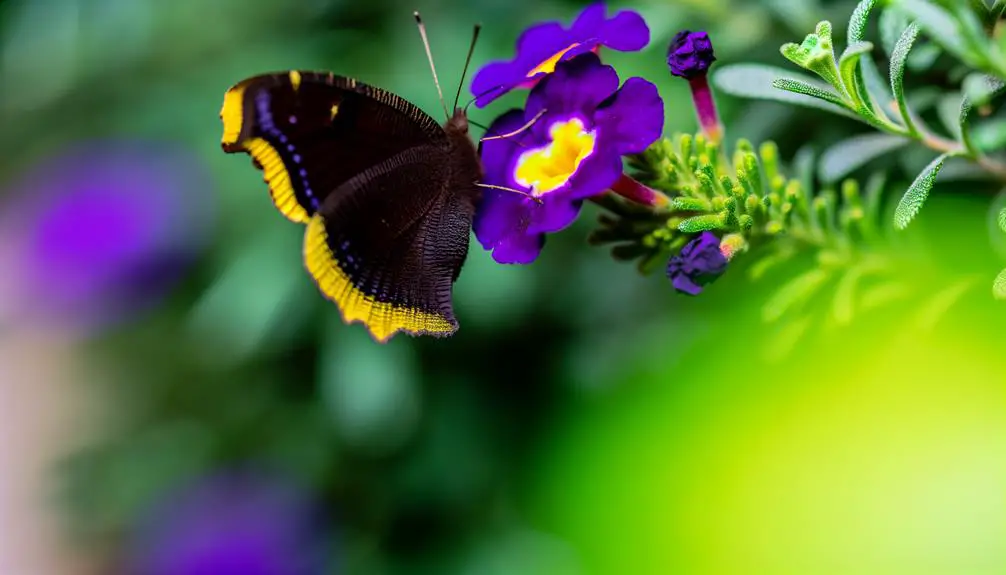
Key Takeaways
- The Mourning Cloak has dark maroon wings with pale yellow edges and iridescent blue spots.
- Its wingspan ranges from 62 to 75 mm, enhancing its distinctive coloration.
- The butterfly exhibits unique scalloped margins on both forewings and hindwings.
- Mourning Cloaks inhabit diverse regions across North America, Europe, and Asia.
Physical Characteristics
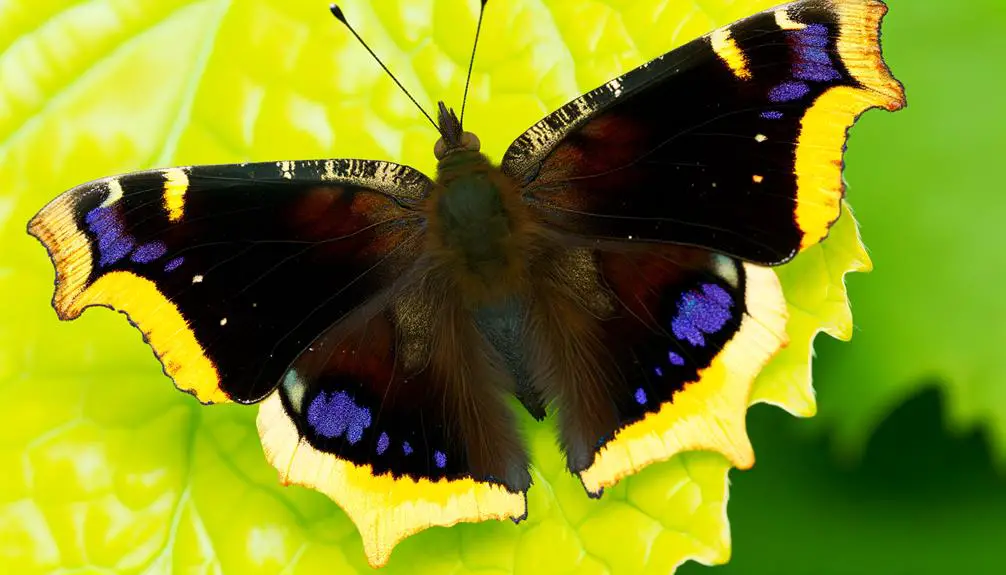
The Mourning Cloak Butterfly (Nymphalis antiopa) exhibits distinctive morphological features, including its dark maroon wings bordered with pale yellow edges and iridescent blue spots.
This Lepidoptera species is characterized by a wingspan ranging from 62 to 75 mm, providing a substantial surface area for its remarkable coloration.
The forewings and hindwings display a unique scalloped margin, enhancing its visual allure.
The ventral side of the wings showcases a cryptic brown coloration with subtle streaks, facilitating effective camouflage.
The body is robust, covered in fine hairs, and supports strong flight muscles.
Antennae are clubbed, aiding in sensory perception.
These morphological traits are not merely for aesthetics but serve critical roles in thermoregulation, predator avoidance, and mating displays.
Habitat and Distribution
Beyond its striking physical characteristics, Nymphalis antiopa occupies a diverse range of habitats across temperate regions of North America, Europe, and Asia.
This species demonstrates remarkable ecological versatility, thriving in deciduous and mixed woodlands, riparian zones, and suburban gardens. It exhibits a preference for environments rich in host plants like willow (Salix spp.), elm (Ulmus spp.), and poplar (Populus spp.) for oviposition.
The Mourning Cloak’s distribution is facilitated by its capacity for long-distance flight, enabling colonization of fragmented habitats. Seasonal migration patterns also contribute to its widespread presence.
In temperate latitudes, N. antiopa can be observed from lowlands to mountainous regions, underscoring its adaptive success across varied climatic and geographical landscapes.
Lifecycle Stages
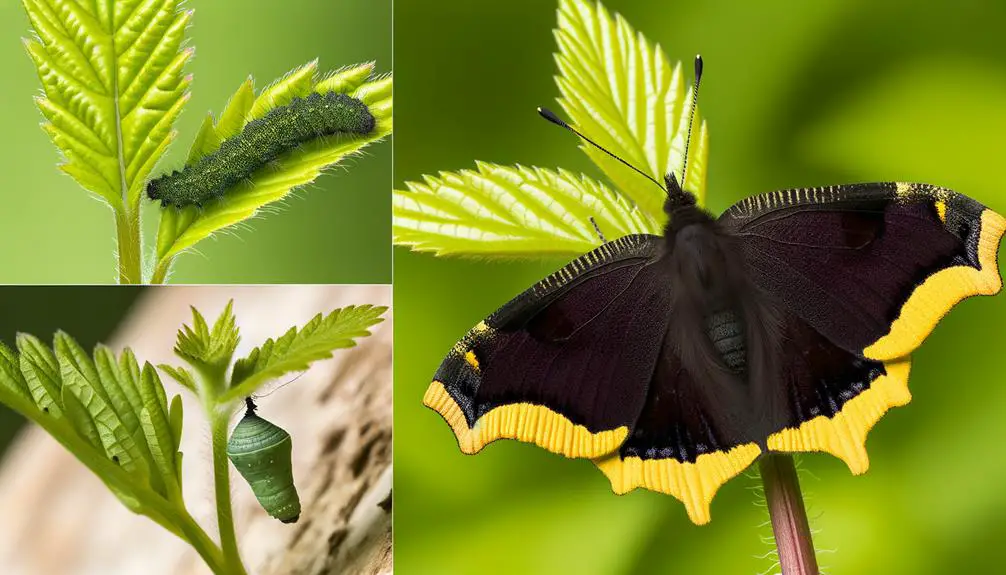
Understanding the lifecycle stages of Nymphalis antiopa reveals its complex metamorphosis, encompassing egg, larval, pupal, and adult phases.
The oviposition occurs on host plants such as Salix and Populus species. Post-embryonic development commences as larvae, known as caterpillars, exhibit gregarious behavior and undergo several instars. The larval stage is marked by a distinctive black body adorned with spiny protrusions and white spots.
Pupation follows, wherein the organism forms a chrysalis, suspending itself from a substrate. This pupal phase is critical for morphological reorganization.
The final metamorphic stage culminates in the emergence of the adult Mourning Cloak, characterized by its velvety black wings bordered with yellow edges and blue spots, signifying sexual maturity and ecological roles.
Survival Strategies
Adaptations such as hibernation, cryptic coloration, and chemical defenses play pivotal roles in the survival strategies of Nymphalis antiopa.
This species exhibits remarkable physiological and behavioral adaptations for overwintering, entering diapause to endure subfreezing temperatures.
Cryptic coloration affords excellent camouflage; the dorsal side mimics dead leaves, evading predation.
Additionally, larvae and adults produce distasteful chemicals, deterring potential predators.
These mechanisms collectively enhance survivability across various life stages, ensuring successful reproduction and population stability.
Furthermore, the Mourning Cloak’s capacity for rapid flight aids in evasion from threats, while their polyphagous larval diet contributes to resilience against food scarcity.
Such multifaceted strategies underscore the evolutionary success of N. antiopa in diverse habitats, from temperate woodlands to urban environments.
Ecological Importance
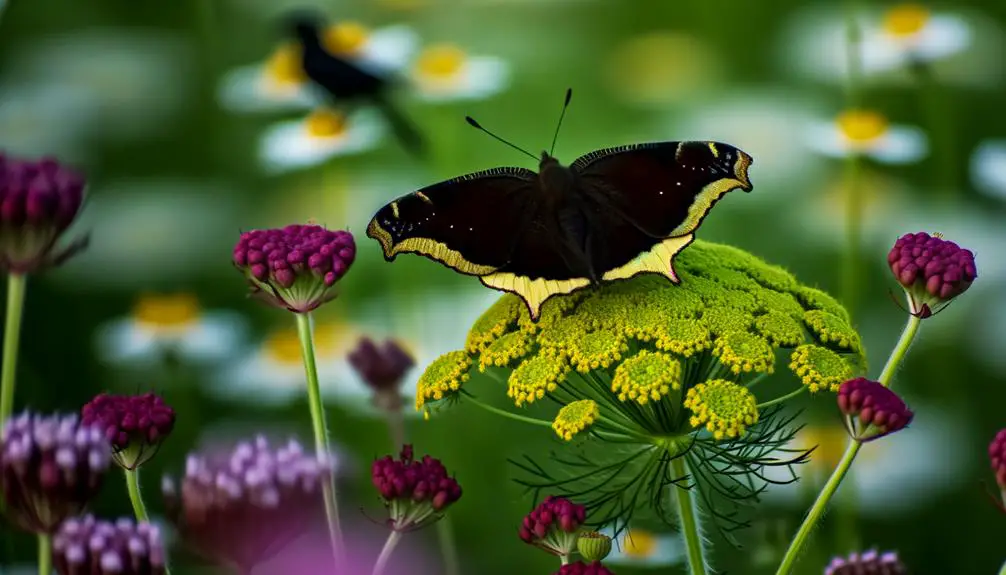
Nymphalis antiopa, with its multifaceted survival strategies, occupies a significant role in its ecosystem by contributing to pollination, serving as a food source for various predators, and participating in nutrient cycling. This butterfly is essential in the pollination of native flora, thereby aiding in the maintenance of biodiversity.
As a prey item, it supports trophic dynamics, providing nourishment for avian, arachnid, and insect predators. Additionally, its larval feeding habits on deciduous trees facilitate nutrient recycling, enhancing soil fertility.
| Ecological Role | Mechanism | Impact |
|---|---|---|
| Pollination | Flower visitation | Biodiversity maintenance |
| Prey | Consumed by predators | Trophic dynamics support |
| Nutrient Cycling | Larval leaf consumption | Soil fertility enhancement |
| Biodiversity Support | Habitat utilization | Ecosystem resilience |
This intricate interdependence underscores Nymphalis antiopa’s ecological significance.
Conclusion
In sum, the Mourning Cloak butterfly (Nymphalis antiopa), with its striking black wings bordered by yellow, exemplifies the marvels of lepidopteran adaptation. This species is known for its remarkable ability to survive harsh winters by entering a state of diapause. The mourning cloak butterfly diet primarily consists of tree sap, rotting fruit, and nectar, allowing it to thrive in various habitats. Its feeding habits, combined with its longevity of up to 11 months, make it one of the longest-living butterflies in North America.
Flourishing across diverse habitats, its lifecycle—from egg to adult—underscores evolutionary ingenuity.
Equipped with unique survival strategies, including crypsis and hibernation, this species contributes considerably to ecosystem dynamics.
Consequently, the Mourning Cloak stands as a symbol of the intricate interplay between morphology, behavior, and ecological function, embodying nature’s intricate tapestry.



